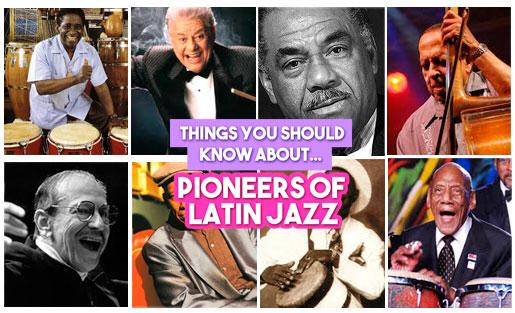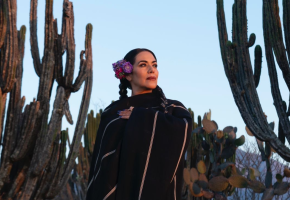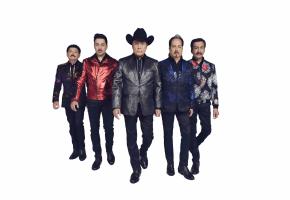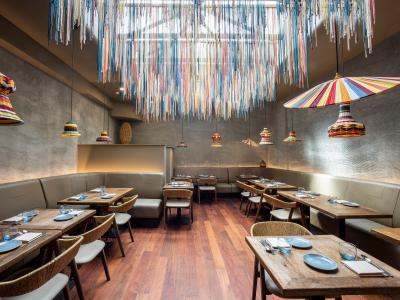1. MARIO BAUZA (1911 - 1993)
It is said that Mario Bauzá's composition "Tangá" was the very first Latin Jazz tune; the first Jazz song to be overtly based in-clave, blending jazz harmony, arranging technique and solos with Afro-Cuban rhythms.
A child prodigy on the clarinet, by age 11 Bauza featured with the Havana Symphony Orchestra and went on to play in Antonio María Romeu's famous charanga orchestra. When the orchestra visited New York City to record in 1926, Bauzá's stayed with his cousin, trumpeter René Endreira in Harlem and played with The Santo Domingo Serenaders, made up of Panamanians, Cubans, and Puerto Ricans. That was enough; shortly after he moved permanently to New York where he became immersed in the bebop scene and, with Dizzy Gillespie, developed cubop, one of the earliest forms of Latin jazz.
In 1939 he co-founded Machito and his Afro-Cubans with his vocalist brother-in-law, Machito). Hugely popular, the band played mambo-style dance numbers at venues such as Manhattan's Palladium Ballroom, becoming famous for their ‘descargas’, the ten to fifteen-minute jams, breaking away from Latin music traditional under-four-minute recordings.
As legend has it, in one rehearsal on May 29, 1943, at the Park Palace Ballroom, at 110th Street and 5th Avenue, Bauza composed "Tanga" (African word for marijuana). It’s success was followed by "Cubop City" and "Mambo Inn."
Bauzá was a master at moving the song from one side of clave to the other. He was the first to explore jazz arranging techniques with authentic Afro-Cuban rhythms on a consistent basis. In Chico O’Farill’s words “It made every other band that came after, followers."
2. MACHITO – (1909 – 1984)
The original NY Mambo King, Machito was the man! Leader of the first big latin band made of latino musicians in the states, the influence that they have in the latino community and the jazz community cannot be measured.
Together with Mario Bauza, Machito refined Afro-Cuban jazz and big band arrangements in their group Machito and Afro Cubans and had a massive impact on American Jazz, bringing African percussion instruments and rythmns the African Americans had lost during the process of slavery. Jazz titans of the day, Dizzy Gillespie, Charlie Parker and Stan Kenton were astounded when they heard their ‘descargas’ [Cuban jam session]
By the time he arrived in the US from Cuba, Machito was already a seasoned sonero (vocal improviser) and a master “Maraquero” (maraca player) and had been part of major bands such as Las Estrellas Habaneras, Conjunto Moderno, Cuarteto Caney and La Orchestra Siboney. His fresh Cuban style contrasted to existing more “Americanised” Latino frontmen such us Perez Prado and Desi Arnaz. Seen as ‘the real deal’ he influenced the next generation of Latino singers who eventually would become the salsa stars of the 70.
In the 70s he changed the format of his Big band to a smaller format and still managed to stay relevant, winning the Grammy Award in 1983.
As a curious note, he died in London where he had a residency at jazz club Ronnie Scott’s. He had a stroke as he waited to perform. An intersection in East Harlem is named "Machito Square" in his honor.
3. Chano Pozo (1915-1948)
Despite only living to age 33, Chano played a major role in the founding of Latin jazz. He co-wrote some of Dizzy Gillespie's “en clave” compositions, such as "Manteca" and "Tin Tin Deo", and was the first Latin percussionist in many famous American Jazz ensembles, including Dizzy Gillespie’s.
Born in Havana The family struggled with poverty throughout his youth. His mother died when he was eleven, and his dad took his family to live with his long-time mistress, Natalia. Chano showed an early interest in playing drums, and performed in Afro-Cuban religious ceremonies (Santeria).
He dropped out of school after the third grade and earned a reputation as a rowdy tough guy, big for his age and exceptionally fit. He spent his days playing drums, fighting, drinking, and engaging in petty crime, which landed him a stint in a youth reformatory in Guanajay, where he learned reading and writing.
Upon his release, Chano took a job selling newspapers. Success in selling brought him to the attention of newspaper owner and influential businessman Alfredo Suárez, who hired Chano as his personal driver and bodyguard. He also began to compose music. Chano's reputation grew for the compositions he wrote for Carnival and in a few years Pozo was the most well-known and sought after rumbero in Cuba. In 1940, his conga composition "La Comparsa de los Dandys," earned his band first prize in the city of Santiago de Cuba's carnival, and has since become a familiar standard at many Latin American carnivals.
Despite his talent, racial discrimination kept him cleaning shoes and selling newspapers in Cuba. On the encouragement of Mario Bauza, in 1947 Chano emigrated to the U.S. where Bauza introduced Chano to Dizzy Gillespie who was looking to include a conga player into his band. He featured in Dizzy Gillespie's Big Band at Carnegie Hall and subsequently on a European tour.
On December 2, 1948 Chano Pozo was shot dead in the El Rio Bar at 111th St and Lenox Avenue in Harlem. Pozo's killer was a local bookie named Eusebio "Cabito" Munoz. Pozo had accused Cabito of selling him poor quality marijuana and Cabito retaliated.
4. Mongo Santamaría (1917-2003)
Mongo Santamaria is arguably the best Conguero ever! Part of that generation of Cuban percussionists who emigrated to the States in the 40s and 50s, Mongo had a fantastic career, recording crossover hits, releasing critically acclaimed albums, playing with the hottest bands around (Fania All Stars, Tito Puente’s, cal Tjader’s) and picking up awards. He was also a master Rumbero and a devoted Santero. He recorded around 50 albums as a band leader, including grammy winner “Dawn” and the comercial hit “Watermelon Man” and he is credited in 100s of recordings.
Santamaría learned rumba as a kid in the streets of Havana, by observing different drummers. "We played mostly music from Africa, but we changed it our way. The music we made dealt with religion and conversation. The drum was our tool and we used it for everything," he reminisced. "When I play I don't know how I do it, or what I do ... I just play."
Mentored on bongos and congas by Clemente "Chicho" Piquero, who played in Beny Moré's band, when Chicho couldn’t join a tour in Mexico in the late 1940s, he recommended Santamaría for the job. Returning from Mexico in 1950, Santamaría moved to New York City, where he became Tito Puente's conga player and then joined Cal Tjader's Latin jazz combo.
In 1959 Santamaría recorded "Afro Blue," the first jazz standard built upon a typical African 3:2 cross-rhythm, or hemiola. He became a leading figure in the pachanga and boogaloo dance crazes of the 1960s. He formed his own charanga, while at the same time recording some of the first rumba and Santería music albums. By the end of the decade, he had his first pachanga hit, "Para ti." He then became a pioneer of boogaloo with his recording of Herbie Hancock’s WaterMelon Man which became an instant hit.
As Herbie recalled: “ Mongo and Donald Byrd were talking about the difference between American and Cuban Jazz, and Donald asked me to play 'Watermelon Man' for Mongo' So I started playing it, and then Mongo got up and he said, 'Keep playing it!' He went on the stage, and playing his congas, and it fit like a glove fits on a hand, it just fit perfectly. The bass player looked at my left hand for the bass line, and he learned that. Little by little, the audience was getting up from their tables, and they all got on the dance floor. Pretty soon the dance floor was filled with people, laughing and shrieking, having a great time, and they were saying, 'This is a hit! This is fantastic!' It was like a movie! So after that, Mongo said 'Can I record this?' I said 'By all means.' And he recorded it, and it became a big hit. That's how it happened.”
The sudden success of the song propelled Santamaría into his niche of blending Afro-Cuban and Afro- American music, recording Cuban-flavored versions of popular R&B and Motown songs. He signed record deals with Columbia, Atlantic and Fania, collaborated with salsa artists and became a member of the Fania All-Stars, often showcasing his conga solos against Ray Barretto. In his later years, Santamaría recorded mostly straight Jazz and Latin jazz for Concord Jazz and Chesky Records.
5. CACHAO (1918 - 2008)
There has been no Cuban bass player more influential than Israel “Cachao” Lopez. A pioneer of the legendary PanArt Cuban Jams (the first latino improvised jam sessions), he also is credited as the co-creator of the Mambo, an evolution of the Danzon. He might not be the most famous Latin musician but he is certainly one of the best to ever do it.
Born into a family of musicians in Havana, Cachao and his older brother Orestes were the driving force behind one of Cuba's most prolific charangas, Arcaño y sus Maravillas, where they pioneered the danzón-mambo, which subsequently developed into an international genre, mambo.
One day in 1957, Cachao gathered a group of musicians in the early hours of the morning, energized from playing gigs at Havana's popular nightclubs, to jam in front of the mics of a recording studio.[6] The resulting descargas (jam sessions) released by the Panart label under the title Cuban Jam Sessions in Miniature, revolutionized Afro-Cuban popular music. EGREM later re-released these descargas, which improvised freely in the manner of jazz, using the vocabulary of Cuban popular music, and are considered one of the most essential Cuban records of the 1950s. Cachao also recorded descargas with Tojo's orchestra and Chico O'Farrill's All-Stars Cubano and worked alongside Peruchín, Tata Güines and Alejandro "El Negro" Vivar.
In 1962, Cachao emigrated to Spain and then moved to the United States in 1963 to join his wife. He soon became one of the most in-demand bassists in New York, New York during the rise of boogaloo, and later, salsa where he played with Charlie Palmieri, José Fajardo, Tito Rodríguez, Tito Puente and Machito, before joining conga player Cándido Camero’s band.
In the 1970s, Cachao fell into obscurity after moving to Las Vegas and later Miami, releasing albums as leader sporadically and weirdly ending up playing at baptisms, comuniones, quinceañeras and weddings. It wasn’t until 1989 that actor Andy García contacted Cachao at the San Francisco Jazz Festival, where he was playing with John Santos and Carlos Santana and asked him if he would be interested in a tribute concert and documentary film made in his honor.
The concert took place in Miami on July 31, 1992, and it was the centerpiece of the four-day 16 mm shoot that yielded Cachao... como su ritmo no hay dos, García's film, released the following year. The success of the concert and film spurred the recording of two new albums, Master Sessions Vol. 1 (1994) and Vol. 2 (1995), as well as international tours. [2]This led to a second "rediscovery" of Cachao, as well as numerous accolades, including several Grammy and Hall of Fame awards.
As a leader, Cachao recorded two more albums to critical acclaim, Cuba linda (2000) and Ahora sí (2004). In 2000, he recorded with Bebo Valdés for Fernando Trueba's concert film Calle 54 and made his last studio recordings as a sideman for Gloria Estefan on 90 Millas (2007). Whilst preparing an album and eight concerts in Europe scheduled for 2008, Cachao died on the morning of March 22, He is ranked number 24 on Bass Player magazine's list of "The 100 Greatest Bass Players of All Time”.
6. TITO PUENTE (1923-2000)
The King! Tito Puente embodied Latin New York for over 50 years. Known as "El Rey de los Timbales" this master percussionist recorded over 100 albums under his name, led one of the hottest Latin/Jazz/Salsa bands ever and was probably the most loved Nuyorican ever!
Born in Spanish Harlem to Puerto Rican parents, Tito was hyperactive, and drove the neighbors crazy with his beating on pots and window frames, until his mother sent him to 25-cent piano lessons. Switching to percussion at 10 he got himself a name in the Latin Jazz scene as a teenager and, when the drummer in Machito's band was drafted to the army, Puente took his place.
Serving in the Navy for three years during World War II, allowed Tito to study music at Juilliard School of Music, where he completed a formal education in conducting, orchestration and theory.
During the 1950s, helped to bring Afro-Cuban and Caribbean sounds like mambo, son, and cha-cha-chá, to mainstream audiences. Puente was so successful playing popular Afro-Cuban rhythms that many people mistakenly identify him as Cuban. Dance Mania, possibly Puente's most well known album, was released in 1958.
Tito took timbal playing to new heights, using his showmanship and charisma to put the instrument at centre stage. But Tito was much more than a timbal player, he was a multi instrumentalist, composer, arranger and band leader who took Latin rythmn to the mass market, compositions like "Oye Como Va" (1963) covered by Carlos Santana, Julio Iglesias, Irakere and Celia Cruz and still endures today.
He was part of the Mambo Kings triumvirate, alongside machete and Tito Rodriguez. His band was famously tight and featured pretty much everyone who was relevant in the latin music world. He was seen as a father figure within the industry and his legacy lives on to this day.
7. CHICO O’FARRILL (1921 - 2001)
As a composer, arranger, and conductor, Chico O’Farrill made a massive contribution to Afro-Cuban jazz or "Cubop", and also composed traditional jazz pieces and even symphonic works. Revered as the best ever arranger of Latin Big band, Chico was instrumental in the development of Latin music and jazz in NY.
A Cuban of Irish and German descent mother, O'Farrill was born in Havana and was raised to follow family tradition and enter into law practice. Instead, he became enamored with jazz music, began studying classical music under Felix Guerrero at the Havana Conservatory and playing in local nightclubs alongside figures like Isidro Perez and Armando Romeu. In 1948, he relocated to New York City, where he continued his classical music studies under Stefan Wolpe, Bernard Wagenaar, and others at the Juilliard School, and began to pursue the jazz scene in his free time.[3]
Soon after moving to New York City, he began working as an arranger for Benny Goodman, and wrote "Undercurrent Blues". He composed works for Machito (Afro-Cuban suite with Charlie Parker, 1950) and Benny Goodman's Bebop Orchestra ("Undercurrent Blues"), and arranged for Stan Kenton (Cuban Episode), Count Basie, Art Farmer, and contributed to several Afro-Cuban jazz works by Charlie Parker and Dizzy Gillespie aswell as started his own band, the Afro-Cuban Jazz Orchestra, during this time, which toured the country, recorded, and played weekly gigs at the Birdland jazz club.
After moving to Mexico with his wife in the 60s, went into obscurity but in the 1990s O'Farrill make a comeback as a band leader led a big band that took up residence at New York's Birdland nightclub. His 1995 release of the Grammy-nominated album Pure Emotion, marked the first time he'd recorded as a leader in nearly 30 years—though he did lead a 17-piece Afro-Cuban orchestra at the Blue Note Jazz Club in New York City a year before, and arranged several songs for David Bowie's jazz-inspired 1993 album Black Tie White Noise, predicting his return.[4][5] He was also commissioned to write a trumpet concerto for Wynton Marsalis at this time.
“When I started my career in the Forties, a lot of Cuban music was very simplistic. I was always more interested in jazz; and when I got to New York, I naturally gravitated to Dizzy and other bebop artists, that fusion of Cuban music with the jazz techniques of harmonic richness and orchestration." Though Chico is heavily associated with the Latin idiom in jazz, his works are typically closer to more mainstream American big band jazz in melody and harmony. O'Farrill states "I was never an expert on Cuban music. What I did, for example, in that suite was purely instinctive [...] They asked me, 'write a suite, Chico,' I just wrote according to my best understanding, letting my jazz sensibility to guide me most of the time."
8. Cándido Camero (1921 - 2020)
Known simply as Cándido, conga and bongo player is considered a pioneer of Afro-Cuban jazz and an innovator in conga drumming. Responsible for the development of tuneable conga sets, as well as the combination of congas and bongos, and other instruments such as the foot-operated cowbell, Candido alongside Mongo, was so sought after that he crossed easily between the worlds of American jazz and pop, Salsa and traditional afro-cuban music.
Born near Havana, at the age of 14, Cándido began to play tres professionally for various son ensembles such as Gloria Habanera, Sonora Piñón and Conjunto Segundo de Arsenio Rodríguez. He switched to the conga, which became his primary instrument, athough he would also record with other percussion instruments, especially the bongo.
Early in his career, Cándido played as conguero and bongosero for the Cuba radio station (for 6 years) and for the Tropicana Club (also for 6 years). As a tresero, he was also a member of Chano Pozo's Conjunto Azul, where he met Mongo Santamaría.
He moved to New York City in 1946, and made his first US recording with Machito and His Afro-Cubans on the tune "El Rey del Mambo." When Chano Pozo was murdered in 1948 Dizzy Gillespie began a fruitful collaboration with Candido that culminated in the 1954 recording of Afro.
Candido was also a member of the Billy Taylor Trio, and performed and recorded with Stan Kenton. As one of the best known congueros in the US, Candido performed on variety shows such as The Jackie Gleason Show and The Ed Sullivan Show and, well into the 60s and 70s recorded several albums as a leader for ABC-Paramount and Blue Note Records.
Unbelievably Cándido was still going well into the 2000s, as a member of the Conga Kings, alongside Patato and Giovanni Hidalgo. They recorded two albums for Chesky and Cándido and recorded another album Inolvidable, with Graciela, the long-time lead singer for Machito. This album earned a Grammy Award nomination.[12] In 2014, Cándido recorded his last album, The Master and continued to perform in jazz clubs in New York pretty much until he died on 7 November 2020. He was 99.
9. FRANSICO AGUABELLA (1925 - 2010)
This Cuban-born master percussionist, teacher and band leader, may not be as well known as some of his contemporaries, for Aguabella move to the West Coast of the United States and alongside Armando Peraza, meant spreading his knowledge to that part of the United States. As a band leader he recorded 8 albums and as a session musician he was as versatile as anyone, recording for artists as diverse as Lalo Schifrin and Eddie Palmieri.
Aguabella was born in Matanzas, Cuba. He demonstrated a special aptitude for drumming at an early age, and was initiated into several Afro-Cuban drumming traditions, including batá, iyesá, arará, olokún, and abakuá aswell as rumba. He said: “The first thing you hear when you wake up in the morning is the drums. You see a bunch of guys on the street, and someone will start clapping his hands, or tapping out a rhythm on a Coke bottle with the bottle cap. You can’t escape the rumba.”
Aguabella made his way to the U.S. by way of a gig with American choreographer Katherine Durham. Francisco performed with many great jazz artists such as Dizzy Gillespie, Tito Puente, Mongo Santamaria, Frank Sinatra, Peggy Lee, Eddie Palmieri, Cachao, Lalo Schifrin, Cal Tjader, Nancy Wilson, Poncho Sanchez, Bebo Valdes, Carlos Santana, and numerous others.
During the 1970s he was a member of the Jorge Santana Latin rock band Malo. Unlike many of his Cuban peers, Aguabella lived in Los Angeles, California, where he never stopped gigging and doing studio work and taught Afro-Cuban drumming to undergraduate and graduate students at the University of California. Aguabella died in Los Angeles on May 7, 2010 of a cancer-related illness.[4]
10. Carlos “Patato” Valdes
The coolest Conguero ever. A hyper charismatic performer, Patato managed to mix superb skill and showmanship on the congas as nobody has ever done: dancing rumba and playing at the same time. He is considered the most melodic of the great congueros. He had long association with jazz musicians such as Kenny Dorham, Art Blakey, Art Taylor and Max Roach as well as Herbie Mann, who he work with for over 15 years and recorded the seminal "African Suite”.
Like many of his Latin Jazz peers, Patato’s craft was honed in Havana, playing at an early age with thewell-known Sonora Matancera, then From 1949 to 1954 for the Conjunto Casino, one of the most popular bands in Havana at the time. In 1952, they toured New York City, where fellow drummer Cándido Camero decided to stay. Patato would make the same decision two years later.
Attracted by New York's thriving jazz scene, Patato left Cuba indefinitely on October 5, 1954.[2] His first full-length recording as a sideman was the notorious LP Afro-Cuban by Kenny Dorham. He went on to perform live alongside Mongo Santamaría and Tito Puente in Harlem. He then joined several ensembles, including those led by Willie Bobo, Machito and Charlie Palmieri. He recorded with jazz drummers Art Blakey, Art Taylor and Max Roach. By the early 1960s, Patato was amongst the most sought-after conga drummers in New York. His association with flautist and bandleader Herbie Mann would last over fifteen years. In 1959, the United States Department of State funded a trip for bandleader Herbie Mann to visit Africa, after they heard his version of "African Suite."
Patato accompanied Dizzy Gillespie and Quincy Jones on extended tours throughout Europe. He acted in and composed the title song of The Bill Cosby Show. In 1977 he took part in the recording of Cachao's comeback albums. In 1991, he contributed to the movie soundtrack for The Mambo Kings Play Songs of Love. Patato was the leader of his own band, Afrojazzia, which toured Europe in the spring of 1994. In 1995 he recorded the album "Ritmo y candela" with fellow percussionists Changuito and Orestes Vilató.
Similarly, together with Giovanni Hidalgo and Candido Camero he released an album in 2000 entitled The Conga Kings. That year he appeared in the documentary Calle 54. In 2001, Patato was inducted into the International Latin Music Hall of Fame.
Think there's someone is missing from the list? don’t worry we have plenty of other lists coming including Great Percussionists, Latin Jazz Legends, Brazilian Jazz Legends and much more. Sign up to our newsletter to be the first to get our great content. In the meantime, check out our Things you should know about...Jazz Greats of Latin America
















